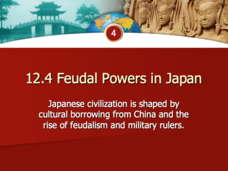Curated OER
Feudal Powers in Japan
One of the most intriguing eras in world history was the shift to Feudalism in Japan. Examine the causes and effects of Japan's religion, culture, borrowing from China, and rise to Feudalism. Facts are given about the Shogunate, Samauri,...
Curated OER
Feudal Powers in Japan
A traditional textbook chapter focuses on feudal powers in Japan, and includes vocabulary, note-taking tips in the sidebar, main ideas, and follow-up assessment questions. It also incorporates opportunities for art analysis and geography...
Curated OER
The Tale of Genji
Did you know that the world's first novel was written by a woman? Murasaki Shikibu's The Tale of Genji, was published in 1021. Class members research Eastern and Western cultures in the 10th and 11th centuries, view modern adaptations of...
Curated OER
The Pillow Book of Sei Shonagon
Twelfth graders deduce the motivation behind and meaning of certain behaviors, conversations and poetry. Students analyze culture's value system. Students compare and contrast Anglo Saxon court culture, Medieval court culture, Medieval...
Indiana University
British Literature Restoration Unit: The Pillow Book – Sei Shonagon
First drafted in the year 996, The Pillow Book contains reflections of those met by a lady-in-waiting in the Japanese court. A brief summary, historical context, and discussion questions are provided on the first two pages. Then, two...
Curated OER
Courtship and Calligraphy in The Tale of Genji
Students discover through an examination of The Tale of Genji the importance of calligraphy to courtship rituals in the Japanese court culture of the late Heian period ( 897-1185). Three possible enrichment activities are included
Curated OER
Feudal Japan
An excellent overview of historical Japanese culture, this presentation could carry through a world history unit or a lesson on the history of Japan. Especially interesting are the slides that compare Japanese armor and castles to other...
Curated OER
The Golden Rule of Reciprocity: A Silk Road Encounters Project
Learners are introduced to the Golden Rule of Reciprocity. Using the four major world religions, they compare and contrast quotes about the Golden Rule. In groups, they create their own version of the Rule and share it with the class.
Curated OER
Comparative religious Teachings
Ninth graders examine the goods and culture that was traded along the Silk Road. For this World History lesson, 9th graders compare and contrast the belief systems of the Silk Roads. Students analyze a primary text of sacred and...
Curated OER
The Kei School
Students create their own Nio sculptures to guard the entrance to the classroom by using knowledge of the Kei school in Japan, primary source documents, and basic art supplies.
Curated OER
Creating Scrolls Based on the illustrated TALE OF GENJI
Students identify formal elements that characterize the scroll, work in a variety of media, from traditional to digital, to create their own scrolls, work into digital printout with at least two media, and engage in meaningful critiques...
Curated OER
WHAT IS A JAPANESE FAMILY CREST?
Students become familiar with family crests in general and Japanese family crests in particular. Students become familiar with the history of Japanese family crests.
Curated OER
Japanese Tanka
Students compare and contrast the two forms of poetry. They are concerned with practicing the styles of both in order to reproduce their own creative work. Research is done to look for the backgrounds of both styles and how they emerged.
Curated OER
The Golden Rule of Reciprocity
Students explore The Golden Rule of Reciprocity from various religions. In this religious beliefs lesson, students examine various religious quotes and summarize the idea of The Golden Rule in a sentence.
Curated OER
Japanese Tanka Poetry
Students discover the techniques of creating Japanese Tanka poetry through in-class discussions and a fun group competition. This lesson is an excellent introduction to Japanese literature and/or poetry.
Curated OER
Belief Systems of the Silk Roads
Students review, compare, and contrast belief systems of the Silk Roads. They analyze primary texts of sacred and philosophical writings. Finally, students recognize the rich diversity of belief systems along the Silk Roads.
Curated OER
My Black Teddy
Young scholars read "Bonnie the Black Bear"and discuss black bear facts. In teams, they research the internet about black bears. They create their own stories about black bears using three facts from the information they've researched.
Curated OER
Japanese Festivals and Celebrations
High schoolers investigate the importnce of celebrations anf festivals in Japanese culture and then create a story based upon an image from the lesson. Resource links are provided for images of events.
Curated OER
Japanese Peasants
Students examine how the Japanese peasant was depicted in art in this high school lesson plan about Asian cultures. Emphasis is placed on individual observations and written reflections.
Curated OER
The Role Of Japanese Women
Students consider the role of women in upper-class Japanese society through the reading of a folktale and the study of Japanese art images. The lesson emphasizes small, cooperative learning groups.
Curated OER
Feudal Japan: Shogun
Students discuss the position attained by the shoguns of feudal Japan, who replaced the emperor as the main source of political power and examine how this power was reflected in art.
Curated OER
Studying Pillow The Book
Students investigate the content of The Pillow Book. They conduct research and complete journals about the readings. There are target questions to guide the writing and reflection process.























